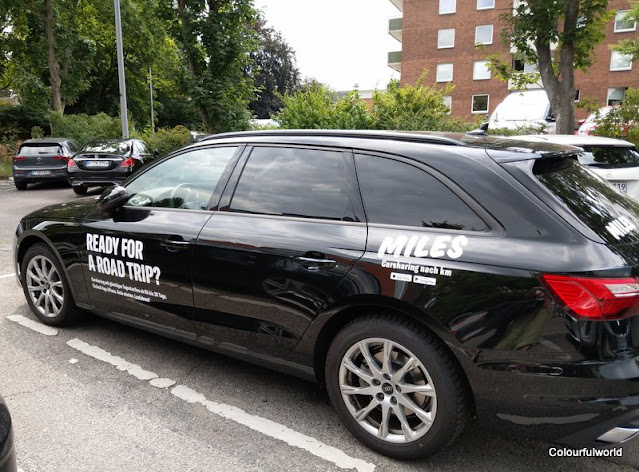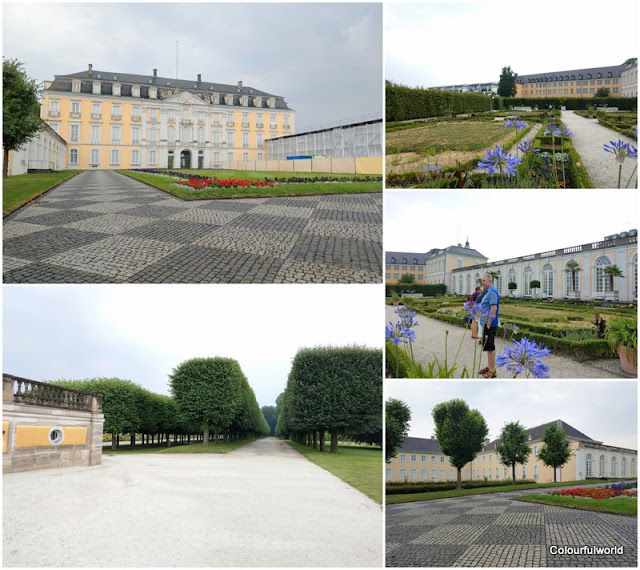As our daughter Karina was working from home for the first few days of our stay, Jose and I had breakfast at a cosy French Cafe in the centre of Bruhl, (C'est la vie, Uhlstraße 49), then took the train to Cologne, just a 30min trip.
Cologne is the fourth largest city in Germany, as well as one of the oldest in the country with a history dating back to the first century AD, when the Romans founded the city they named Colonia.
 |
| C'est la vie - French bakery in Bruhl, and our breakfast croissants |
Steps away from the main station is the Cologne Cathedral - a Catholic cathedral built in the Gothic style, which was started in 1248 and finished according to the original plan in 1880.
It is the world's third tallest church, the second in Europe, and Germany's most visited landmark with an average of 20 thousand people a day.
Maintenance work to the Cathedral is carried out constantly, as wind, rain, and pollution slowly eat away at the stonework, and there is a non-profit organization, the ZDV, which was founded to promote and finance the never-ending restoration work.
 |
| Model of the Cathedral's filial on top of the towers, which is 9,50mt high and 4,60 mt wide/ Side portal of Roman North Gate, built in 50AD bearing the city's name - Colonia Claudia Ara Agrippinensium |
The Cathedral is indeed stunning and as we walked around admiring the construction, the art, the floors, the stained glass windows, the statues... we wondered how the builders and the artists managed to achieve such beauty, such greatness, such engineering feats without the building technology we have nowadays.





 |
| Wooden model of the Cologne Cathedral |
We left the Cathedral and looked for a coffee shop to have a refreshment, and just around the corner at the Old Market Square we found lots of eateries with outdoor tables and chairs under umbrellas. We sat down at one of them and ordered drinks and snacks.
Nearby was the Heinzelmännchenbrunnen (Heinzelmännchen/Pixies fountain) in front of the Früh brewery. It was built in 1899 by Edmund Renard and son Heinrich and commemorates the Heinzelmännchen (little gnomes) - the little people who according to the legend did all the work at night so that the people of Cologne could laze around during the day. (You can read about the legend here: https://www.travelsignposts.com/Germany/sightseeing/heinzelmannchenbrunnen-cologne
 |
| The Heinzelmännchen fountain (Heinzelmännchenbrunnen) |
As we walked towards the Hohenzollern Bridge we saw the area behind the Cathedral where I presume the reconstruction work takes place.
The 409,19mt (1,342.5 ft) long Hohenzollern Bridge is the iconic bridge over the Rhine, which was destroyed during WW2, and reconstructed. Originally a railway and road bridge after its reconstruction in 1945 it is only accessible to trains - over 1200 a day, and pedestrian traffic.
Named after the House of Hohenzollern, the rulers of Prussia and German Emperors, the bridge has four equestrian statues of Prussian and German emperors flanking each end of the bridge.
The bridge is famous for the countless number of lovelocks attached to the fence, a customs which started in 2008. Apparently the German Bahn (railways) sees no danger for the bridge and estimated that it could carry 15 tons of extra weight! In 2015 the number of locks was estimated to be 500 thousand!
 |
| I found a lock dated 6 July 22, the day before our visit to Cologne
|
 |
| Boats on the Rhine, one of the statues on the bridge, the back of the Cathedral seen from the bridge |
From the bridge we walked along the banks of the Rhine to the charming historical Old Town with its narrow streets flanked by traditional old houses, pubs, and restaurants, museums, fountains and statues.
 |
Old town - fountain, bronze monument of Tünnes and Schäl opposite St Martin's church, the red house dates from 1643, and interesting street lamp, a statue with a horse near St Martins's church, interesting window with flower boxes
At the water's edge is the Cologne Fish Market with its Gothic candy coloured houses built in the 12th century, likely constructed as part of the adjacent Benedictine Abbey. The area was once the site of the city's fish market dating back to the 13th century. During WWII when 90% of the city was flattened, part of the old town was rebuilt to their original designs after the end of the war. Behind the buildings the Great St. Martin Church peeks through.

|
Behind the Fish Market is the Great Saint Martin Church, a Catholic church founded on the site of a Benedictine Abbey, erected between 1150-1250. The church was badly damaged during WWII and restoration was completed in 1985.
Cologne's City Hall (Rathaus) situated between two squares - Rathausplatz and Alter Markt, houses part of the city's government, with various structures in different architectural styles and includes the offices of the Lord Mayor, and is Germany's oldest city hall with over 900 years of history.
 |
| The various building of the City Hall (Rathaus) which include the 15th century Gothic tower. A bridal couple was just coming out of the city hall after their wedding ceremony |
 |
Various statues in the plazas

|
 |
A store selling gigantic animal statues. Any buyers out there?
|
Another landmark on my list was the 4711 Cologne house. The traditional "Eau de Cologne" has been produced here since 1799. Nowadays they have many colourful bottles apart from the traditional one.
We ended our day in Cologne with a stop at a cafe for another drink and snack before going to the main station to get the train back to Bruhl.
 |
| Signs: Die Maus?, colourful bike, Bum bum Boris, lol, advert for the $9 Euro monthly transport ticket |
This advert at a pub by the Town hall was hilarious - "Beer is now cheaper than petrol, so don't drive on, drink a Kolsch (Cologne beer) on the spot at 1,80Euro"

Beer is cheaper than petrol

























































